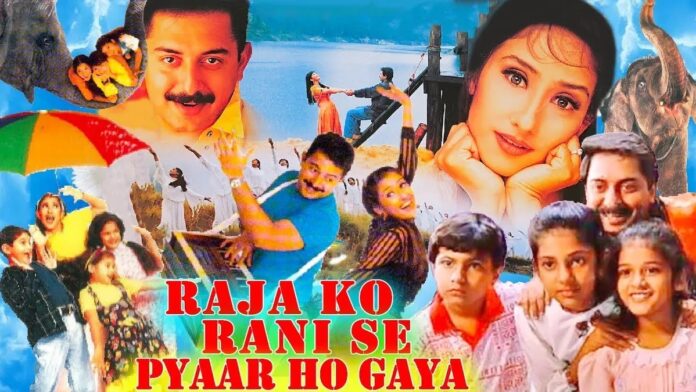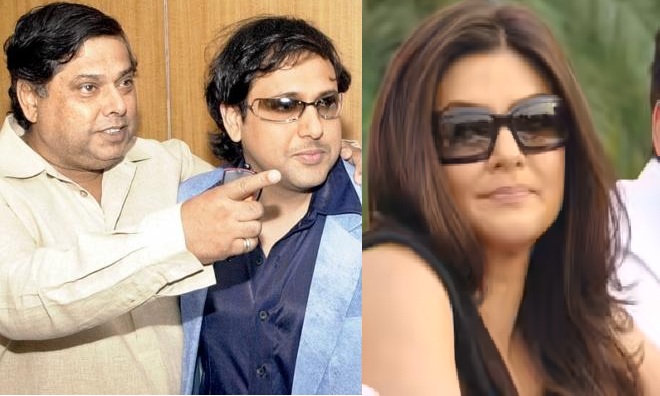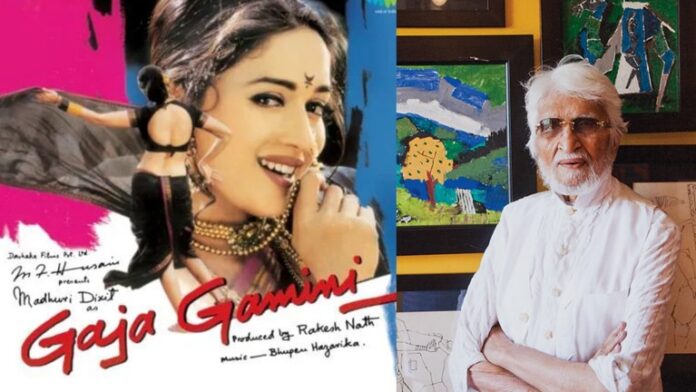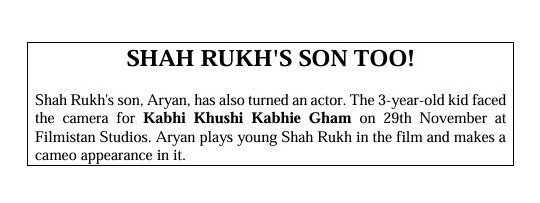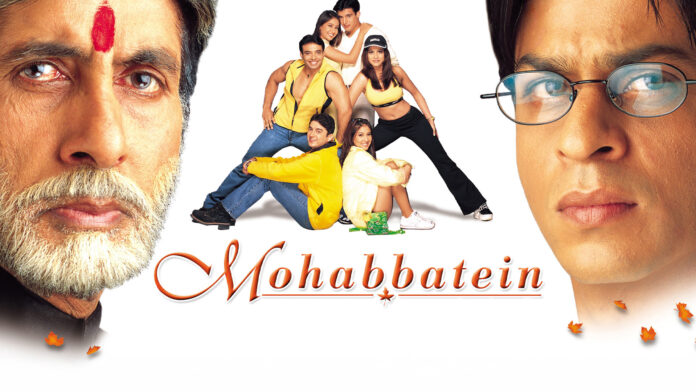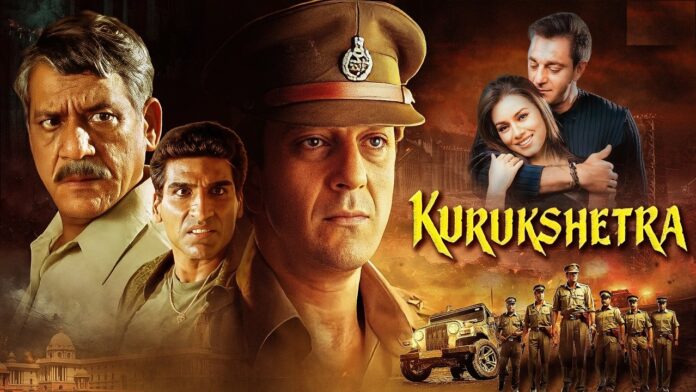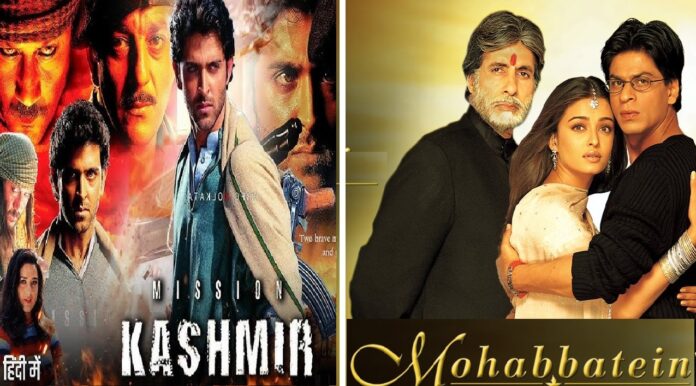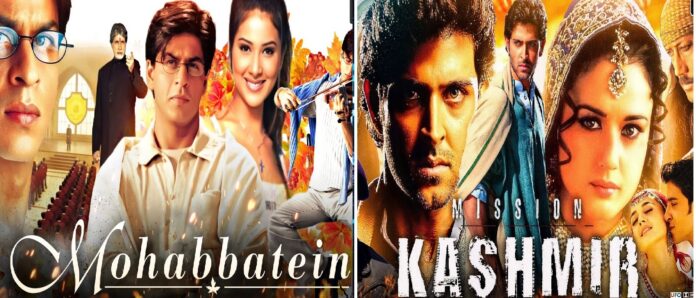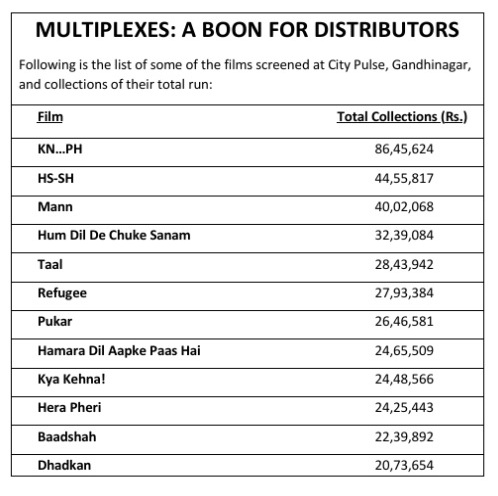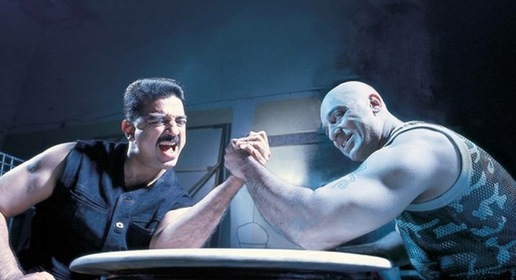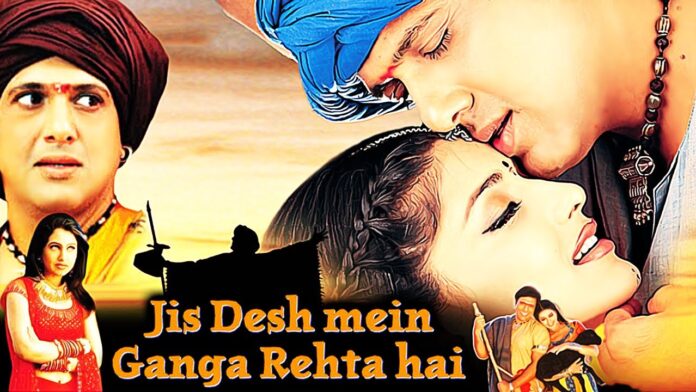RAJA KO RANI SE PYAR HO GAYA
Shogun Films Ltd.’s Raja Ko Rani Se Pyar Ho Gaya is a fairy tale kind of a film. A child grows up with a dream to marry a princess. As a handsome adult, he befriends a pretty girl who, unknown to him, is a princess. He first meets her when he saves her life in his village. Unable to strike a rapport with her there, he sets out for the city where she lives, with the sole purpose of meeting her. His brother, nephew and nieces also stay in the same city. The pretty princess gifts the guy a baby elephant, having accidentally broken his elephant idol which is worshipped by his family as a deity. While the kids start loving the animal, it is found to be a nuisance by members of the housing society in which the guy lives with his brother’s family and the elephant. The silliest part is that the brother and his wife for many days don’t realise that an elephant is staying with them in their flat! When the brother does get to know about the presence of the elephant, he orders it to be thrown out. Ultimately, the elephant comes back to the house.
In the meantime, having lost his heart to the girl, the handsome guy one day proposes marriage to her. She declines his offer as she had been married off in her childhood to a boy who has grown up to be a menacing villain. On being prodded by his grandmother, the guy rescues the princess from her villain-‘husband’. He is aided in his climax fight by the baby elephant.
T.K. Rajeev Kumar’s screenplay is as pathetic as his story. A handful of scenes do appeal but the major part of the film is sickeningly dull. Dialogues are simple.
Arvind Swamy does well but a younger man was the need of the fairy tale. Manisha Koirala is good. Elephant Appu pleases at places. Dina Pathak, Goga Kapoor, Dilip Dhawan, Tanvi Azmi, Priya Tendulkar, Shahbaaz Khan, Kunika and the child artistes lend fair support.
T.K. Rajeev Kumar’s direction is too dull to be true. Music (Jatin Lalit) is average although a couple of songs have been beautifully picturised (Kala and Ahmed Khan). Ravi K. Chandran’s camerawork is splendid. Action (Thyagarajan) is just about tolerable.
On the whole, Raja Ko Rani Se Pyar Ho Gaya, which has taken years to be completed and reach the cinemas, is a disaster. Staleness apart, it is almost devoid of entertainment of the kind liked by today’s audience.
Released on 22-12-2000 at New Empire and 10 other cinemas of Bombay by Shogun Films Ltd. thru Shringar Films. Publicity: fair. Opening: poor. …….Also released in Delhi-U.P., West Bengal and Mysore.
U.A. THADANI CRITICAL
The condition of leading Bombay exhibitor-distributor and Theatre Owners’ Association president U.A. Thadani continues to be critical at the Breach Candy Hospital, Bombay. His condition is causing great anxiety not only to his family members and relatives but also to his friends in the Bombay film trade, particularly in Naaz building.
Thadani was hospitalised two weeks back and has been in the ICU of the hospital for lung malfunctioning and other complications.
HRITHIK-SUZANNE WEDDING CEREMONY A PRIVATE AFFAIR
All the guesswork and speculation came to an end on 20th December when Hrithik Roshan and Suzanne entered into matrimonial alliance in Bangalore following an engagement ceremony the previous day. The milni ceremony, prior to the wedding, had J. Om Prakash and politician Ghulam Nabi Azad representing respectively Hrithik’s dad, Rakesh Roshan, and Suzanne’s dad, Sanjay Khan.
The wedding was held at Sanjay Khan’s Golden Palms Resort & Spa in Bangalore. It was a private affair. Rishi Kapoor, Jeetendra, Prem Chopra and Sujit Kumar were among the few select guests who attended the wedding. The pressmen and photographers were kept at bay by the security guards.
The newly-married couple will arrive in Bombay on 24th December (Sunday) from where they will take off for a honeymoon (destination undisclosed).
MUSIC DIRECTOR SANJEEV WEDS
A reception to celebrate the wedding of music director Sanjeev (of Sanjeev Darshan), son of music director Shravan, with Ritika was held on 21st December at Hotel Centaur, Juhu, Bombay.
HC REJECTS ANUPAM KHER’S PLEA TO RESTRAIN ZEE
A plea by Anupam Kher to restrain Zee TV from removing him as the host of Sawaal Dus Crore Ka was rejected by Justice K.K. Baam of the Bombay high court on 20th December. Kher had claimed in his plea that Zee TV could not terminate his contract as it had promised that it would not conduct the game show without him as one of the hosts. The promise had, argued Kher, prompted him to sign away his copyrights as a performer on the show, especially since he was told by Zee TV that he would be one of the hosts for 156 episodes. Kher had been paid Rs. 1 crore initially and was being given Rs. 2.5 lakh per show. The total contract for 156 episodes was worth Rs. 3.9 crore.
While accepting Zee TV’s submission that the contract was of personal service and hence no injunction could be granted on Kher’s plea, the judge observed that the contract was not of an exclusive nature. He held that the contract did not prevent Anupam Kher from taking up other assignments in his acting career, but only stipulated that the actor set aside eight days every month exclusively for the show. He also added that Kher could claim damages from Zee TV if his removal from the show was held unlawful by an arbitrator.
Virag Tulzapurkar argued for Zee Telefilms. Janak Dwarkadas was Anupam Kher’s counsel.
In a related case, Zee on December 21 served a legal notice on Anupam Kher, asking him to tender an apology within 10 days for making allegedly defamatory statements against the company or face a Rs. 100 crore defamation suit. The notice states that Anupam had defamed the company in the press by saying that the show was bad and that it did not have proper lighting. Kher is also alleged to have said that there was no coordination between the organisers and the participants.
SALMAN, SATISH SHAH SUMMONED BY COURT
Salman Khan and Satish Shah have been summoned by a Jodhpur court to appear before it on January 27, 2001 in connection with the black buck poaching case. Salman had been arrested under various sections of the IPC, Wildlife Act and Arms Act in 1998 for hunting black bucks, but was released on bail. He was allowed permanent bail with a provision that he should appear before the court when summoned.
FIRE AT MEHBOOB STUDIOS
Two shooting floors at Mehboob Studios were gutted in a fire which broke out at 2 a.m. on 20th December. While stages 1 and 2 of the studio perished in the fire, the firemen managed to save the recording room, the make-up rooms and the studio owners’ residence after a three-hour battle to put out the fire. Since the studio was closed at the time, no one was injured.
The sets of Rohan Sippy’s Kuch Na Kaho and Meghna Gulzar’s Filhaal, which were erected on stages 1 and 2 respectively, were reduced to ashes. Reportedly, the cost of the Filhaal set, erected by art director Nitin Desai, was Rs. 32 lakh.
The cause of the fire is yet to be ascertained. The studio management does not suspect any foul play.
AMITABH UNVEILS STATUE OF SELF AT TUSSAUD’S
Amitabh Bachchan unveiled his wax statue at Madame Tussaud’s museum, London, on 20th December. Amitabh was immensely impressed with the quality of work of his wax version. He expressed his gratitude to Madame Tussaud and said that it was an honour not only for him but also for the people of India. He described the statue as “an incredible piece of art”.
NAZIM RIZVI’S MAN FRIDAY ARRESTED
Eight days after the arrest of producer Nazim Rizvi (Chori Chori Chupke Chupke), the crime branch of Bombay police arrested his personal assistant and close confidante, Abdul Rahim Khan, in connection with the controversy surrounding the financing of Chori Chori Chupke Chupke. Twenty-five-year-old Khan has been accused of having links with the underworld and has, like Rizvi, been booked under the Maharashtra Control of Organised Crime (MCOC) Act.
The crime branch had detained Khan for questioning since the day of Rizvi’s arrest (13th December) and had interrogated him for eight days prior to arresting him on 21st. He was remanded to police custody till 27th December by a metropolitan magistrate.
Meanwhile, the negative of CCCC continues to lie sealed by the police at Adlabs. The police, which had seized the negative under section 20 (2) of the Act, has now issued a notice, as per court’s order, asking any other “bonafide claimant of the negative to approach the court within 15 days”. Bharat Shah, the film’s financier and the negative rights holder, has so far neither staked his claim nor moved court as he had said, he would.
Earlier, on 16th December, the film’s directors, Abbas and Mustan, as also its lead man, Salman Khan, were interrogated in the case. Bharat Shah was questioned on 15th and 16th. He has submitted the source of funding of CCCC to the crime branch.
CINEMA CLOSURE IN MAHARASHTRA CALLED OFF
The one-day protest strike by cinemas of Maharashtra on 20th December was withdrawn on an assurance from the home secretary, government of Maharashtra, to the film industry that the government would take steps against illegal telecast of films on cable TV networks. Accordingly, cinemas all over Maharashtra functioned as usual on 20th.
The strike call was jointly given by the Indian Motion Picture Distributors’ Association (IMPDA), the Cinematograph Exhibitors’ Association of India (CEAI), the Theatre Owners’ Association (TOA) and the Central Circuit Cine Association (CCCA).
‘KAHO NAA…PYAAR HAI’ GOLDEN JUBILEE
Producer-director Rakesh Roshan’s Kaho Naa…Pyaar Hai, the box-office wonder of the millennium year, entered 50th combined week at Novelty (matinee), Bombay and other centres of the country on 22nd December.
While Rakesh Roshan surpassed all his previous hits with this film, his brother, music director Rajesh Roshan, gave ample proof of his musical prowess. And what’s more, Rakesh’s son, Hrithik Roshan, was bestowed with instant stardom on its release. Amisha Patel also achieved stardom. The film co-stars Anupam Kher, Farida Jalal, Mohnish Bahl, Dalip Tahhil, Satish Shah, Ashish Vidyarthi, Tanaaz Currim, Vrajesh Hirjee and Johny Lever (in a guest appearance). Honey Irani and Ravi Kapoor’s script, Sagar Sarhadi’s dialogues, Kabir Lal’s cinematography, lyrics (penned by Saawan Kumar, Ibrahim Ashq and Vijay Akela), Tinnu Verma’s action, Farah Khan’s choreography, Sanjay Verma’s editing, and R. Varman’s art direction contributed in no small measure to the film’s super-success.
50-DAY CELEBRATIONS OF ‘MOR CHHAINHA BHUINYA’
The 50 days’ run of the trend-setting Chhattisgarhi film, Mor Chhainha Bhuinya, was celebrated with felicitations at cinemas screening the film.
At Babulal Talkies, Raipur, where the film is running in daily 5 shows, the cinema’s owners, D.K. Jain, M.K. Jain and Kamal Jain, honoured the film’s producer, Shivdayal Jain, writer-director Satish Jain, music director Babla Bagchi, lyricist Lakhman Masturiya and the film’s artistes. Lavanya Tiwari, secretary, Chhattisgarhi Cine Association, also felicitated the film’s writer-director.
The proprietors of Sharda Talkies, Durg, Anil Jadav and Ajay Jadav, also honoured the film-makers and the artistes while the owners of Manohar Talkies, Bilaspur organised a function to celebrate its 50 days. It was attended by Bilaspur mayor Uma Shankar Jaiswal. The film’s distributor, Pooran Entertainments, Bhilai distributed sweets among its staff.
In the meantime, Satyanarayan Sharma, minister for higher education, Chhattisgarh, saw the film on 16th December in Raipur and praised it for highlighting the Chhattisgarhi culture.
PREM PRAKASH, JAIPUR TO BE RENAMED GOLCHA
Surendra Golcha and Abhimanyu Golcha’s Prem Prakash cinema in Jaipur will be renamed The Golcha on the occasion of its golden jubilee.
Amitabh Bachchan will unveil the cinema’s new name at a function at the cinema on 26th December. Yash Chopra will be the guest of honour. The cinema is currently screening Mohabbatein.
NEW CINEMA IN BIJAPUR
Apsara Theatre 70mm, a new cinema in Bijapur, owned by Shravankumar B. Mahindrakar, was inaugurated on 21st December by Rakesh Singh, district magistrate of Bijapur. It has 572 seats. The air-conditioned cinema opened with a Kannada film, Nee Nanna Jeeva.
In accordance with the policy of the Karnataka government, the cinema will enjoy an entertainment tax holiday for the first three years.
NARESH KANODIA CELEBRATES HIS SONS’ WEDDINGS
Actor-producer and music director of Gujarati films, Naresh Kanodia, and his music director brother Mahesh Kanodia hosted a cocktail-dinner party for their friends from the press to celebrate the weddings of the former’s two sons — music director Sooraj and Gujarati film actor Hitu. The party was held on 20th December at Nandkrupa Hall, Andheri, Bombay. Mahesh Kanodia, elder brother of Naresh Kanodia, welcomed the invitees.
Earlier, on 12th December, a reception to celebrate the weddings was held at the Hare Krishna Temple Garden, Juhu. It was a grand affair and was attended by the bigwigs of the Gujarati film industry. Several Gujarat ministers, including Faqir Waghela, Raman Vora, Narayan Patel, Khodbhai Patel, Tulsi Dabhi, Jayanti Barot, Ishwar Makwana and Nalin Bhatt, also attended the reception, Ratilal Varma (MP) and MLA Shailesh Parmar were also present.
Incidentally, the venue of the marriage and reception was Hare Krishna Temple Garden because the grooms had expressed their desires to enter into matrimony in a temple.
CENSOR NEWS
Emaar Films International’s Chori Chori Chupke Chupke (social) was given C.C. No. CIL/2/47/2000 (UA) dt. 18-12-2000; length 4560.20 metres in 18 reels (cuts: 4.64 metres).
Devgans Films’ Raju Chacha (social) was given C.C. No. CIL/1/81/2000 (U) dt. 21-12-2000; length 5096.63 metres in 18 reels (cuts: 27.09 metres).
Shree Shiv Bhakti Films’ Champion (crime) was given C.C. No. CIL/3/130/2000 (A) dt. 18-12-2000; length 4180.08 metres in 16 reels (cuts: 20.37 metres).
3-E
Education-Entertainment-Enlightenment
B4U: Bharatbhai For You
Topmost film financier Bharat Shah’s interrogation by the crime branch of Bombay police in the sensational Chori Chori Chupke Chupke case is all fine, but the negative publicity being given to Shah on a couple of television channels gives the impression that it is now turning into a channel war.
Bharat Shah’s involvement in the B4U channel is too well-known. Zee and Star TV have been rather harsh on Shah in their news bulletins and other shows, feel top industry people. A top producer-director, wishing to remain anonymous, said, “The two channels seem to be capitalising on this case by dragging Bharatbhai’s name into it more than required. The channels seem to have made up their minds that Shah was guilty and had a nexus with the underworld even though the police haven’t drawn any such conclusions.”
More Multiplexes
The Dainik Jagran group of newspapers, extremely popular in Northern India, is now set to get into the business of multiplexes. One 3-screen cineplex with other entertainment facilities, a huge shopping mall, parking space for 250 cars and the works will be open to the public in Kanpur in May 2001. Shailesh Gupta, the 29-year-old member of the 53-member joint Gupta family of Kanpur, is the man behind the multiplex called Rave. The name ‘Rave’ has been derived from Ravi and Vedant, the sons of Kothari (Gupta’s partner in the multiplex) and Shailesh Gupta respectively. Kanpur is only the beginning; the next city Shailesh is targetting for the multiplex is Lucknow.
A Valentine’s Launch
The debut film of Salman Khan’s younger brother, Sohail Khan, and Sameera Reddy will be a love story. Titled Maine Dil Tujhko Diya, it will — quite appropriately — go before the cameras on Valentine’s Day, 14th February, 2001.
Sohail himself will be directing the film which is produced by him jointly with partner Bunty Walia. Kabir Lal, who shot newcomers Hrithik Roshan and Amisha Patel in 2000’s biggest blockbuster, Kaho Naa…Pyaar Hai, will be the cinematographer for this romantic story too.
On being asked if the choice of Valentine’s Day to start shooting was a conscious decision or a coincidence, Bunty Walia said, “It is deliberate. Why? Because the film is a love story and Valentine’s Day epitomises love. Let me also add that we will be releasing the film on Valentine’s Day 2002!”
In the meantime, songs of Maine Dil Tujhko Diya are being recorded currently by Anu Malik’s younger brother, Daboo Malik.
Only Meethi, Nothing Khatti
Rahul Rawail is a happy man even before the release of his Kuch Khatti Kuch Meethi. For, Pritish Nandy Communications has entered into a deal with Rahul for all the territories for which his film was till now unsold. PNC has agreed to pick up all those territories at the market price of the film. B.L. Saboo, the first-time partner of Rahul Rawail in KKKM, can’t believe that film production is so easy! For, Saboo and Rawail have got more than their investment back with minimum efforts, thanks to PNC.
Baroda Exhibitors: Championing Their Cause
Baroda exhibitors have formed a syndicate like the one which exists in Surat. The syndicate has decided not to pay crazy prices to distributors for booking their films. Bookers have for quite some time now been doling out unheard of monies to distributors and, in the process, have often burnt their fingers. So it is hardly surprising that sanity should have been restored. The syndicate is now determined not to go by the bookers’ dictates. The first impact of the unity was felt in the release of this week’s Champion. Although a leading booker had committed a fancy price (Rs. 10 lakh) to the film’s distributor for a cinema of Baroda, the concerned cinema refused to honour the commitment. Resultantly, no cinema had been finalised in Baroda for Champion till the eleventh hour. Quite literally so! For, Champion was finalised at Sagar cinema of Baroda at 11 o’clock on the night of Thursday (21st December)! That too, at less than half the earlier price committed by the booker.
SHOWBIZ TODAY
R World:
It’s Our Whole New World!
You enter the long promenade after parking your vehicle and are flabbergasted by the sheer vastness of the multiplex that surrounds you. Are you in Hollywood? While you might just be as close in India as you can get to being in Hollywood, you realise that you are at R World, the multiplex marvel which has recently come up at Adalaj, near Gandhinagar in Gujarat.
As you pass the main entrance and stop to gaze at the high pillars, each displaying a backlit poster of forthcoming films, you may tend to miss out on the tiny neon lights fitted deep into the floor. If each pillar boasts of a backlit poster, the high walls of the cineplex can’t by any lesser, for, on them are mounted backlit close-ups of Hollywood stars in one row and our very own Bollywood stars in another. There’s a huge TV screen, too, in the grandiose foyer, just in case you don’t want to miss Kaun Banega Crorepati or …Kyunkii Saas Bhi Kabhi Bahu Thi! While you are still trying to grasp every picture and every bit of the eye-catching illumination, your attention is drawn to the bowling alley — ‘Future Bowl’. Yes, you can try your hand at bowling amidst some soulful music. And mind you, you’ll be provided special shoes for this sport, lest you slip on the smooth wooden floor.
A walk down the lobby takes you to the music shop, appropriately called ‘Listen’. Try out the numbers before buying an album.
Is it your best friend’s birthday tomorrow? Don’t worry, just pick up a card from the ‘Cards & Gifts’ shop.
Kids, too, have ample choice to have a whale of a time — from playing in the park (on the slides, see-saws and what have you) to striking cars (yet to be started) to watching their favourite cartoon films on the ‘Kid Screen’ to relaxing in the thoughtfully-conceptualised ‘Mother’s Room’. And if kids are net-savvy, you just might want to drop them at the Cyber Cafe for a while.
Oh dear, how did I forget the video parlour with its innumerable exciting video games and air hockey boards? What’s that now? Well, I can’t tell you everything: some games are better played and enjoyed than explained. Feeling hungry? Twenty-two, yes, 22, varieties of popcorn await you at ‘Catch 22 Corns’, ‘Popcorn & Nachos’ & ‘Top Corn’. Popcorn is not enough of a meal for you? Want something more filling? Just wait till the gates of ‘Food Hunt’ are opened sometime next month, where among others, Birdy’s by Taj, Just Around The Corner & Dosa Diner will provide their goodies.
And what is a ‘Banquet Hall’ doing here? Yes, you can also have an engagement or birthday party right here! Sounds unbelievable, isn’t it?
But hey! just a minute, you are here to see a film, remember? Yes, you are here to see a film on one of its three screens. So, here’s more about the three cinemas housed in the R World complex.
Each cinema is divided into two classes — Gold and Platinum. Cinema I has 462 seats in the Gold category (stalls), Cinema II has 336, and Cinema III has 337 seats. Each of the three cinemas has 100 seats in the Platinum (balcony) class. The ticket rates vary between Rs. 60 and Rs. 150 depending on the film being shown — Hindi or English. There is a single projection system for all the three screens.
Now we come to the posh push-back seats made of pure leather. Luxury at its very best! You have to sit in the seats to experience the comfort — never before experienced in any cinema in India (Psst! In case the film is boring, you may feel more inclined to just stretch your legs and lie back in the plush seat. Before you can spell S-L-E-E-P, you’ll be fast asleep! No thanks to the boring film, but all thanks to the coziness of the chair.)
Hello, if you think all the leisure activities (video games, bowling alley, go-karting and many more which are still to come) are for free with a film ticket, think again. Whoever said, all good things come for free? Each service comes for a price, whether the parking space for your vehicle or the games you play or the cyber cafe or just about everything except the Kid Screen. Nevertheless, such is the quality of the services that you don’t really feel the pinch in the pocket.
Although, the extravagance of the multiplex must have really pinched the pocket of Ajay Sinh Chudasama. But it is money very well spent! Indeed, anyone who visits the place will be prompted to say, “R World is our world!” Well, actually it is out of this world! You have to see it to believe it!
– Meena Nahta





























